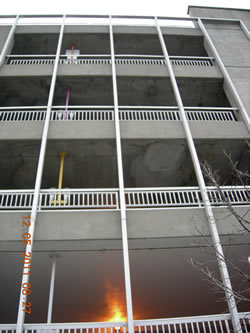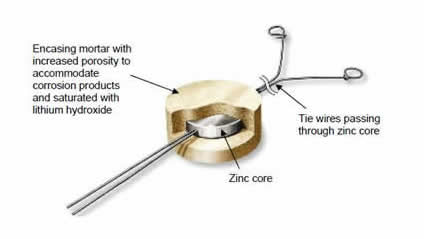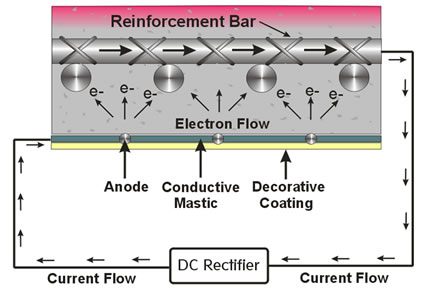Extending the Life of Old Concrete Structures
by More Than Twenty Years
Reinforced concrete, a miracle invented by the ancient Romans, provides shelter to many humans. Why is it that Roman concrete lasted 2000 years when our modern, "improved" concrete often cracks after 20 years of service? The answer is in our use of reinforcing steel bars, or rebars. These are rods embedded in concrete to make the concrete stronger than it otherwise would be.
Roman structures had no rebars that corrode, but we do. Fortunately, we know how to protect rebars from corrosion. We can make our existing structures last longer than 20 years.
For new construction, there are several options. An expensive option is construction with stainless steel rebars. We can also coat rebars with plastic, or galvanize them with zinc. Or, we may embed anodes for cathodic protection.
Of all these methods, the only one available for existing, aging structures is cathodic protection. This is a cost-effective technique that protects metals by the application of a minute current of electricity. This technology, popular in such far-flung places as Florida and Saudi Arabia, is only slowly making inroads in the Northeast. If more owners knew the benefits of cathodic protection, more would consider employing it for the longevity of their concrete structures.
The photo below shows the 300,000 square foot Dane County parking garage in Madison, Wisconsin. This structure is more than 50 years old. When it was rehabilitated 20 years ago, concrete spalls were replaced with fresh mortar on all its 5 floors. Unfortunately for the county, only the bottom 2 floors were cathodically protected. The photo shows the result: the second floor ceiling is in excellent condition, whereas spalls in the top 3 floors had since to be re-patched at considerable expense to the county.

Dane County Garage, Madison
Wisconsin.
To save money, the county applied cathodic protection
to only the bottom two floors. The bottom floor ceilings
are in excellent condition, but costly patching
had to be applied to the upper three floors.
To stop rebar corrosion, the secret is to apply cathodic protection. This solution can be applied to either isolated problem spots or to large areas.
To treat isolated problem spots, an anode provides the current. The next time you repair a concrete floor, or a spall in a ceiling, have your contractor do his usual repairs and also insist that he apply cathodic protection. To accomplish this, he should clean and attach a zinc anode to the exposed rebars (see Figure 1), then have it encased in mortar. Each anode, costing only $60, can provide cathodic protection for approximately 20 years to an area of 5 to 10 square feet.

Figure 1. This hockey puck-sized
zinc anode is manufactured by VectorTM.
It can be attached to rebars with its tie wires, then encased in
regular mortar
to provide cathodic protection for 20 years or more to isolated problem
spots.
When there are more isolated concrete spalls than can be counted, owners are told that their entire structures must be demolished because of the "aging concrete". This is when impressed current cathodic protection should be investigated. Simply put, the cost of this solution could be as low as 10 percent of the cost of a new structure.
Impressed current cathodic protection can be applied on wide areas of concrete with conductive painted anodes and a power supply, or rectifier, that works on the same principle as your cell phone charger.

Figure 2. Impressed current cathodic
protection applied
to a wide area of concrete (courtesy of MATCORTM).
When applying large area cathodic protection, concrete repairs must be applied only where the concrete has disbonded from the rebars. It is easy to find these spots by simply tapping the surface with a hammer. If the tapping does not sound hollow, then the concrete is bonded. Where disbonded, the concrete must be removed from the rebars, the rebars cleaned off, and mortar reapplied.
The anode system that provides the current is made of titanium coated with platinum wire electrodes that are embedded in a conductive carbon bearing mastic paint. To minimize labor, the paint is applied mainly to non-traffic surfaces such as ceilings and vertical walls. The black can be covered with a decorative topcoat of any color. The current is spread through the concrete, directly to the rebars. Using this method, the cathodic protection protects the surfaces of the traffic floors and prevents ceiling spall. Many car parking garages, doomed by structural engineers 20 years ago, have been preserved by cathodic protection to provide income to owners.
There is a downside to impressed current cathodic protection. Annually, a qualified technician should verify that the system has been active. It takes about a day to perform the inspection, but the costs are miniscule when compared with the cost of patching spalls and skyrocketing premiums from injury claims.